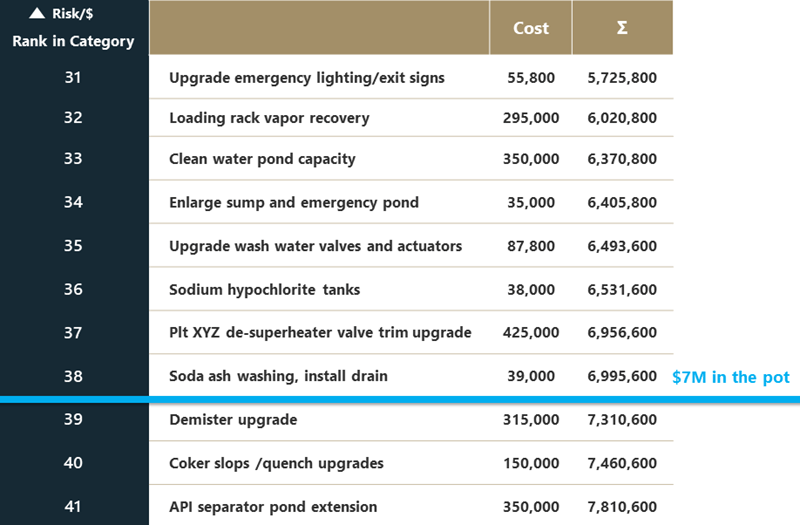Category C: Small brownfield projects with a high degree of variability
These are found in and around aging process facilities; many Category C projects resemble major maintenance tasks but without an expectation of being repeated. Scope, arrival time, resource requirements, sponsorship, business drivers, and complexity are all over the map. Once approved, a project competes for shared resources every week with dozens of similarly variable tasks until it is handed over to Operations.
At most aging facilities, the Category C portfolio is increasingly dominated by sustaining projects which reduce risk and increase asset integrity. Only a few purely ROI projects will be funded if the asset decay curve is steep, because the first step in making money at an old facility is to stop losing it to poor reliability. We need a rate of asset improvement to overcome the rate of asset decline.
Of course, this means that if the asset needs hundreds of improvements, hundreds of projects need to meet their Operations Acceptance milestone.
While clients and contractors currently govern this work as individual projects, improved capital effectiveness does not arise from improved project-level predictability. For Category C, Capital Effectiveness comes from picking the slate of projects that most improve the asset per dollar spent, and then finding ways to maximize the overall pace of completion.
But how do you select best bang for the buck work in a portfolio dominated by risk reduction projects? Fresh thinking is required to apply economics to improvements in risk. For each possible project we’ll need risk deltas, i.e. an estimate of both initial risk, and residual post-completion risk. When risk deltas are translated into numeric values they allow projects to be compared regardless of size. Bang for the buck is just risk delta divided by project cost, and there’s a value for each project on the list. To maximize Capital Effectiveness in picking, favor those projects with the highest Bang for the buck, and work down the list over time.

Once the slate of projects is selected, pace of completion comes less from project management and more from fields like Queuing Theory and Economics. Because most of a Category C project’s life span is spent waiting in a queue somewhere, we apply practical lessons from Queuing Theory to improve flow and perform at the economically optimum level of ‘busy.’ One unexpected management lever is the number of active projects competing for limited resources.
Pace of completion for Category C is predominantly driven by portfolio management, not individual project management. That’s the primary reason for distinguishing Category C from Category A and B work. If we aren’t optimizing ‘traffic’ levels in this category we aren’t optimizing portfolio value.
There’s so much variance across different companies’ facilities that the most meaningful benchmarks of improvement for Category C are comparisons with previous years’ performance at the same location. Risk deltas can be summed just as NPVs can be summed. Organizations can be aligned around picking the best projects for this year’s budget and then improving the pace of completion compared to previous years.
If maximizing Capital Effectiveness is the target, what’s the mantra for Category C? Bang for the buck at the overall best pace. It’s important to overcome the rate of asset decline with a rate of asset improvement.
What about cost certainty? While it’s annoying if a fire water system replacement project comes in at 25% over budget, it likely would still have been approved at the higher figure had it been known. What’s less acceptable is having no replacement fire water system in place before the original system fails. And it’s never helpful when people pad initial estimates and schedules to create an illusion of certainty.
Conclusion
Each of the three categories of brownfield work has different drivers and a different path to maximizing Capital Effectiveness. Each one is about bang for the buck at the best pace, but each roadmap is different. Using the principles outlined in this article, we’ve helped clients generate step changes in asset improvement per annual dollar spent, improving what matters most.
 Some clients have doubled their Capital Effectiveness for Category C work within 24 months through our straightforward, transparent, and reproducible techniques. Results can be measured by improved Brownfield Capital Effectiveness, and the benefits will be evident in plant operations and business results.
Some clients have doubled their Capital Effectiveness for Category C work within 24 months through our straightforward, transparent, and reproducible techniques. Results can be measured by improved Brownfield Capital Effectiveness, and the benefits will be evident in plant operations and business results.
We know what it takes to help organizations understand the true causes of their challenges and to identify and implement solutions. We’re here to help you be better portfolio managers, to strengthen your business by getting more asset improvement sooner, for less.
The road up to best passes through better; we’re ready to help you refocus your portfolio management journey until you can confidently continue on your own.





 Some clients have doubled their Capital Effectiveness for Category C work within 24 months through our straightforward, transparent, and reproducible techniques. Results can be measured by improved Brownfield Capital Effectiveness, and the benefits will be evident in plant operations and business results.
Some clients have doubled their Capital Effectiveness for Category C work within 24 months through our straightforward, transparent, and reproducible techniques. Results can be measured by improved Brownfield Capital Effectiveness, and the benefits will be evident in plant operations and business results.